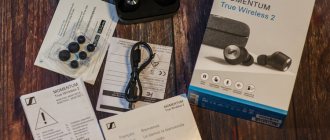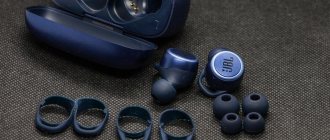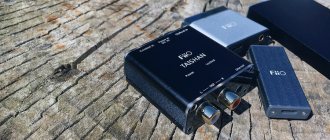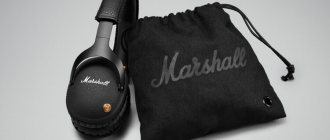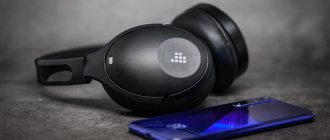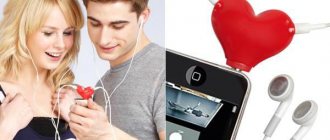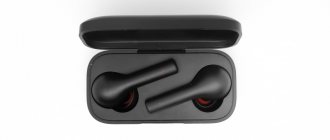comparison table
| Name | Design | Number of microphones (pcs) | Active Noise Cancellation (ANC) | Working time (h) | Weight (g) | Average cost (RUB) |
| Apple AirPods Pro | In-canal | 2 | + | 4.5 hours; in a case – 24 hours | 5,4 | 19990 |
| Soundcore Liberty Air 2 Pro | In-canal | 6 | + | 7 hours; in a case – 26 hours | 3,8 | 11990 |
| Xiaomi Mi True Wireless Earbuds Basic 2 | In-canal | 1 | — | 4 hours; in a case – 12 hours | 4,1 | 1820 |
| Xiaomi Redmi AirDots 2 | In-canal | 1 | + | 4 hours; in a case – 12 hours | 4,1 | 1580 |
| Samsung Galaxy Buds Live | Earbuds | 3 | + | 8 hours; in a case – 29 hours | 5,6 | 9990 |
| HUAWEI FreeBuds 4i | In-canal | 2 | + | 7.5 hours; in a case – 22 h | 6 | 5940 |
| HONOR Earbuds 2 Lite | In-canal | 2 | + | 10 hours; in a case – 32 hours | 5,5 | 4450 |
| JBL Tune 215 TWS | Earbuds | 1 | — | 5 hours; in a case – 20 hours | 5 | 3793 |
| Realme Buds Air 2 | In-canal | 2 | + | 5 hours; in a case – 25 hours | 4 | 5490 |
| Sony WF-XB700 | In-canal | 1 | — | 9 hours; in a case – 18 hours | 8 | 5990 |
TWS headphones for dummies. How are they different and which one is better to choose?
Reader rating for this article: 4.9
(274)
TWS headphones are becoming more and more popular every day. The term TWS (True Wireless Stereo) itself translates as truly wireless stereo and means headphones that are not connected by wire either to a smartphone or to each other.
This class of devices appeared in December 2016, when Apple introduced its first TWS headphones, AirPods. And today this company occupies a leading position in the market. According to the analytical company Strategy Analytics, in 2022, every second TWS headphones sold in the world were Apple AirPods (market share - 54.4%):
Overall, over 107 million devices were sold in 2022, and this figure will only grow in the future. For example, according to analysts from Counterpoint, more than 100 million AirPods alone will be sold in 2020. And Strategy Analytics estimates the TWS headphone market at $100 billion/year by 2024 (more than 1.2 billion devices).
All this suggests that users are growing in interest in this class of products, and in this regard, we will tell you how different TWS headphones differ, what to look for when purchasing, and how to choose the best option.
Please note : many headphone models in the article will be highlighted with links. By clicking on the link you can read our detailed review of a specific model.
TWS headphones and sound quality
Obviously, one of the main criteria when choosing headphones, whether TWS or regular, is sound quality. And there are a lot of nuances and misconceptions here.
By design, all TWS headphones are divided into two types: in-ear and in-ear. A lot depends on this parameter alone, so let’s immediately look at what their differences are.
TWS earbuds
These are headphones that are placed in the auricle and do not tightly close the ear canal. An example of such devices are the mentioned Apple AirPods or Huawei FreeBuds 3:
Huawei FreeBuds 3 TWS earbuds
Their main advantage is precisely the fact that the ear canal remains open. Accordingly, such headphones do not create a feeling of “vacuum” in the ears, do not completely block out external sounds and do not hear your voice loudly during a conversation.
The earbuds are very convenient to use as a headset. They are quickly and easily inserted into the ears, have one size and do not create discomfort when worn.
The main disadvantage of earbuds is the same open ear canal. The fact is that only with complete isolation of external sounds can you achieve the deepest bass and the highest quality sound.
For this reason, earbuds are not considered “musical” headphones in the full sense of the word. You will never find a musician using earbuds on stage. In addition, finding expensive earbuds on sale (even wired ones) is very rare, since in-ear models often dominate the Hi-Fi segment (here we are not taking into account on-ear and full-size headphones).
In-ear TWS headphones
In-ear headphones, as the name suggests, are inserted directly into the ear canal, isolating it from external sounds. Such headphones are always supplied with a set of interchangeable ear pads (tips) of different sizes to take into account the physiological characteristics of each user.
There are plenty of examples of in-ear TWS headphones: Apple AirPods Pro, Xiaomi AirDots, Samsung Galaxy Buds, Sony WF-1000XM3 and many others.
In-ear TWS headphones from Sony and Apple
Of course, the type of headphones itself says absolutely nothing about the sound quality, but at a minimum, in-ear headphones will provide more bass on a noisy street than earbuds. All other things being equal, the sound of in-ear headphones will be richer and richer, especially in a noisy place.
The speaker size of TWS headphones does not affect the sound quality!
Many manufacturers indicate the size of the speakers of their TWS headphones, sometimes even emphasizing this. This is especially true for Chinese companies. In reality, the size of the speaker has nothing to do with sound quality and only misleads the buyer.
The analogy with speaker systems suggests that the larger the speaker, the deeper and more powerful the bass it produces. Accordingly, the smaller the speaker, the better it reproduces high frequencies (the same tweeter is several times smaller than the woofer). However, this does not work with in-ear headphones.
Many models with tiny drivers (~6 mm) produce deeper and better bass than headphones with huge drivers (~14 mm). The best examples are the aforementioned Sony WF-1000XM3 (6 mm speaker) and Huawei FreeBuds 3 (14.2 mm speaker). Sony headphones sound an order of magnitude better across the entire frequency range, delivering deeper bass and cleaner highs.
One of the most famous (now former) Sennheiser engineers, Axel Grell, has always considered the optimal speaker size for in-ear headphones to be within 6.5 mm . Further increase in size, at a minimum, does not improve sound quality.
Therefore, the last parameter that you should pay attention to when choosing TWS headphones is the size of their speakers.
However, the speakers themselves play one of the key roles, since they ultimately reproduce all the sounds. What matters is what materials they are made of, as well as what frequency range they are able to reproduce. But these parameters only indirectly indicate sound quality.
Codec support and audio volume for TWS headphones
Many people make one mistake, believing that the cost and quality of a smartphone can somehow miraculously affect the sound quality of Bluetooth headphones. This common misconception comes from the analogy of wired headphones.
The fact is that when we connect a wire, the signal from digital must be converted to analog, and then sent to the headphones through this wire. The quality of digital-to-analog conversion is of great importance and is responsible for this special device inside the smartphone called a DAC.
But when we connect wireless headphones, there is and cannot be any conversion from digital to analog. The signal must be sent in digital format via Bluetooth to the headphones, and the TWS headphones, having received this digital signal, convert it to analog before sending it to the speakers.
Accordingly, the DAC and amplifier of the smartphone do not have any effect on the sound quality of wireless headphones. It all depends on the DAC and amplifier, which are built directly into the headphones. For the same reason, the volume of headphones often does not depend on the smartphone. But sometimes there are exceptions when the volume is limited by software by the smartphone.
And yet, something in a smartphone can affect the sound quality - this is the set of supported codecs . For a better understanding, we need to look at this issue in more detail.
The main problem with wireless audio is Bluetooth bandwidth. We cannot send uncompressed files with a high bitrate (data flow rate) to headphones via Bluetooth. The bitrate of most Bluetooth headphones is limited to 256 or 328 kbps.
No matter how high-quality our audio file is (even flac with a bitrate of 1411 kbps), a file with a quality not exceeding mp3 (320 kbps) will reach the headphone DAC.
This happens because the smartphone first compresses (encodes) the source file with certain losses, and then sends it to the headphones. Those, in turn, must decode the signal. But since certain data was lost during compression, it will not be returned during decoding.
The same codecs . The smartphone and headphones must support the same codecs in order to “understand” each other. The basic SBC codec is supported by all devices in the world. But support for other codecs depends on the specific model. By the way, some smartphones also do not support all codecs. This is especially true for those devices that do not operate on the Qualcomm platform (for example, smartphones from Huawei or some Xiaomi).
In theory, if the headphones support, for example, the LDAC codec , we can get Hi-Res sound in maximum quality with virtually no loss. That is, there will be no difference between high-quality wired headphones and Bluetooth with LDAC support (in terms of sound quality). After all, the LDAC codec supports data transmission with a bitrate of up to 990 kbps , which is 3 times higher than when using SBC or AAC codecs.
Therefore, when choosing headphones, you can pay attention to the supported codecs. If you sort them in ascending order of quality, then the list will look like this:
- SBC
- A.A.C.
- aptX
- aptX HD
- HWA(LHDC)
- LDAC
But here, unfortunately, not everything is so simple. No matter how high-quality (lossless) the sound file is, if the headphones have a bad audio chip, this will not play any role. There are cheap Chinese TWS headphones on the market with support for aptX and aptX HD codecs, which will sound an order of magnitude worse than high-quality models with only SBC support.
In other words, almost any characteristic of TWS headphones gives only an indirect “hint” about sound quality. And some of the most important parameters cannot be measured or assessed at all. We are talking about such key concepts as:
Space, stage width and depth, instrument separation
For example, what's wrong with the expensive Apple AirPods Pro headphones? They have large drivers (11 mm), good frequency range, and excellent ear canal isolation. And, nevertheless, comparing their sound quality with the sound quality of the Sony WF-1000XM3 or, especially, the Sennheiser Momentum TW, is completely incorrect.
These models from Sony and Sennheiser have incredible instrument separation as well as stage feel. By increasing the volume, you only “push” the sound (scene) to the sides. The sound of one instrument does not affect the sound of all the others. There is no “mess” of sounds even on the most complex compositions.
All this cannot be reflected in the device specifications.
Or take a more banal thing, such as sibilance, when certain sounds are played with an unpleasant whistle that hurts the ear. How can this be displayed on the product website?
There is only one conclusion that can be drawn. There are TWS headphones on the market that are almost as good in sound quality as expensive wired models, but you can choose them either based on reviews or check them yourself when purchasing. All parameters that describe sound are greatly influenced by marketing. If something is measured in numbers, those numbers can be "stretched" in many ways without necessarily improving the actual quality of the product.
Using TWS headphones as a headset
Many people buy TWS headphones for use, including as a headset (for talking on the phone). It doesn’t matter whether you are saving yourself from phone radiation in this way or it’s just more convenient for you, you need to understand that not all TWS headphones cope well with this task.
First of all, don't forget about the design of the headphones. Inserts will be the most convenient in this regard. On the other hand, there are quite a few in-ear headphones on the market that feature sound permeability . When this technology works, headphones use microphones to pick up external sounds and send them through the speaker at a certain volume. As a result, it seems as if there are no headphones at all.
However, this feature does not work equally on all models. For example, the first Galaxy Buds sound like a hearing aid in this mode. The Sennheriser Momentum TW and Sony WF-1000XM3 are nicer in this regard.
And in the Apple AirPods Pro headphones, this function is literally brought to perfection. When you turn on the permeability mode, the headphones seem to disappear. You hear all surrounding sounds without the slightest distortion.
AirPods Pro
First conclusion: to work as a headset, it is better to use earbuds or in-ear headphones with sound permeability mode.
The second important point is the number of microphones in the headphones. If each TWS earphone has only one microphone, it will be very difficult to use them for conversation in a noisy place. The person you're talking to will hear all the noise around you, perhaps even louder than your voice.
Two or more microphones on each earbud are used for noise cancellation to cut out all extraneous sounds.
However, two microphones are not a panacea. Some models still do a poor job of canceling noise during a call, especially in a noisy place. The same Sony WF-1000XM3 is a clear negative example.
Sony WF-1000XM3
But there is also the opposite example, when headphones are literally “tailored” for use in headset mode. Take, for example, Huawei FreeBuds 3 with microphones hidden inside the “legs” to protect against wind, as well as with a vibration sensor that amplifies the sound that occurs when the jaw joint vibrates. We talked about this in more detail in the corresponding review.
What else is important to pay attention to when choosing TWS headphones
In addition to all of the above, TWS headphones differ from each other in additional functions. Let's briefly consider the most popular of them:
Noise suppression
ANC (from the English Active Noise Cancellation - active noise reduction) is a special software and hardware algorithm that suppresses (damps) external sounds. With these headphones you can comfortably listen to music even in the noisiest places.
The very principle of noise reduction is very simple - with the help of microphones, the headphones pick up all external sounds and then play them in antiphase. That is, the rise of the wave of one sound signal (say, the sound of a car outside) coincides with the decline of the wave of another signal (the same sound of a car recorded by a microphone and played in antiphase). Because of this, the effect of damping the sound wave occurs (since the waves overlap each other):
Ideally, external sound should disappear completely, but in practice this effect is difficult to achieve even with full-size headphones.
If you don't understand all these terms (antiphase, sound wave, etc.), then read our new popular science article about what active noise cancellation is in headphones.
Typically, active noise cancellation is found on in-ear headphones, but there are rare exceptions when this function also works on earbuds.
Active noise cancellation is available in such TWS headphones as:
- Apple AirPods Pro
- Audio-Technica ATH-ANC300TW
- Sony WF-1000XM3
- Jabra Elite Active 65t
- Huawei FreeBuds 3
- Xiaomi Air Mi True Wireless
Built-in equalizer
An equalizer can be found in many music applications on a smartphone. It allows you to change the sound character of melodies by increasing or decreasing the volume of certain frequencies. For example, you can add bass or make more high frequencies.
The problem with such equalizers is that they work exclusively in one application. As soon as you launch another application, the headphones will return to their previous (factory) sound.
But there are TWS headphones with a built-in equalizer, which is configured not in a specific music application, but in a proprietary program produced by the headphone manufacturer. By adjusting the equalizer once, the sound will be identical in all applications.
Not all models have a built-in equalizer. For example, not a single AirPods or Xiaomi has it. But it is available on Samsung Galaxy Buds, headphones from Sony and Sennheiser.
Branded application
Some headphones have proprietary applications that allow you to update the firmware and configure various functions. To check whether a specific headphone model supports an application, simply search for its name in the Google Play Store or AppStore (depending on which platform you need the application for).
Autonomy
Pay attention to how long the headphones last on a single charge, how many full charge cycles the case’s battery lasts for, and whether the case supports wireless charging.
There are cases when the headphones do not turn off completely in the case, but continue to work in a special energy-saving mode. This allows them to reconnect to the device very quickly when opening the case. However, this advantage is fraught with rapid self-discharge of the headphones and case when you do not use them.
For example, Apple AirPods can stay in a case for a month without running out of charge, and Sennheiser Momentum TW will drain its own battery and the case’s battery in just a week, even if you haven’t picked them up.
And that is not all…
Some models have additional unique features. For example, AirPods Pro constantly measure the volume of music using internal microphones and record it in the application, assessing the impact on your hearing:
Sony is able to suppress external sounds while at the same time amplifying people's voices, that is, the noise of cars will be muffled, but the conversation of people will not. Huawei headphones allow you to adjust the intensity of noise cancellation. And sometimes there is a Multipoint function, thanks to which headphones can be simultaneously connected to two devices and, for example, listen to music from a laptop while staying in touch by phone.
As you can see, TWS headphones differ from each other not only in appearance and sound quality. And given the specifics of this topic, it is advisable to check the sound yourself before purchasing. Or, at a minimum, read high-quality and unpaid reviews, which is what we actually do at Deep-Review!
PS
Don't forget to subscribe to our popular science website about mobile technologies in Telegram so you don't miss the most interesting things! If you liked this article, join us on Patreon for more fun!
How would you rate this article?
Click on the star to rate it
There are comments at the bottom of the page...
Write your opinion there for all readers to see!
If you only want to give a rating, please indicate what exactly is wrong?
Final rating table
| Place | Name | Ya.Market |
| #1 | Apple AirPods Pro | Buy |
| #2 | Soundcore Liberty Air 2 Pro | Buy |
| #3 | Xiaomi Mi True Wireless Earbuds Basic 2 | Buy |
| #4 | Xiaomi Redmi AirDots 2 | Buy |
| #5 | Samsung Galaxy Buds Live | Buy |
| #6 | HUAWEI FreeBuds 4i | Buy |
| #7 | HONOR Earbuds 2 Lite | Buy |
| #8 | JBL Tune 215 TWS | Buy |
| #9 | Realme Buds Air 2 | Buy |
| #10 | Sony WF-XB700 | Buy |
Sound
It can hardly be said that this F9 tws model has high-quality sound. The relatively small diameter of the dynamic drivers cannot recreate rich bass, but the mid and high frequencies will please even picky music lovers.
High internal resistance slightly reduces the maximum volume, but prevents wheezing and stuttering.
Equipment
The standard features of the wireless F9 include:
- Packing box - 1 pc.
- Charging case - 1 pc.
- Plugs - 2 pcs.
- USB Type-A/Micro USB charging cable - 1 pc.
- Ear pads - two pairs.
- User manual in English - 1 pc.
- Warranty card - 1 pc.
Another pair of medium-sized ear pads was originally placed on the F9 tws plugs.
Does the Bluetooth version of headphones matter?
Bluetooth version is important, but not always for the reasons you might think. For example, Bluetooth 5.0 doesn't really affect sound quality, so having it on board doesn't mean they'll sound better than a pair using version 4.2. But the range and stability of the connection will increase. And this is perhaps even more important.
Sometimes TWS can be quite unusual.
This way you can move around the house more freely without taking your phone with you everywhere. In fact, the speed of data transfer is also increasing with the release of new versions of Bluetooth, but this force is not channeled into increasing sound quality.
Advantages
- Ergonomic design.
- High quality materials and workmanship.
- Sound.
- Autonomy F9.
- Using the charging box as a Power Bank.
- Display of the battery charge of the case on a digital display.
- Built-in microphones allow you to use the gadget as a wireless headset.
- The presence of noise reduction during telephone conversations.
- Waterproof against sweat and rain splashes.
- Compatible with iOS and Android devices.
- Possibility of volume control.
- Cover with magnetic clasp.
- Dimensions and weight.
- When open, the case can be used as a smartphone stand.
How to charge
To charge the box, the kit includes a USB Type-A/Micro USB cord, with which the IN port is connected to a network adapter, laptop, computer or other device.
The charging process and completion will be reflected on the digital display. The same cable can also be used to charge a smartphone from the case, only now you need to select the OUT port.
The F9 wireless headphones themselves begin to charge, as soon as you place them in the charging case. Since the external and internal charging connectors are not protected, it is necessary to ensure that foreign objects do not fall into them and to clean them regularly.
Only the large dimensions of the original Amoi F9 charging box and the economical placement of tws headphones in it can make it possible to install a battery of such an impressive capacity inside. All subsequent models do not meet the declared parameters for autonomy.
Flaws
- When using the F9 Bluetooth headset for gaming or watching movies, the sound lags behind the video signal.
- The charging contact pads get dirty quickly.
- Insufficient microphone sensitivity.
- If you use ear pads not included in the package, the wireless F9 may not charge in the case.
- Legacy micro-USB charging port.
Buy on Aliexpress
Amoi F9 has excellent autonomy, comfortable wearing and control, and also has the ability to use the case as a Power Bank, they have conquered many.
However, for watching video files and gaming, it is better to purchase other tws headphones, since the sound of this model lags significantly behind the video signal.

